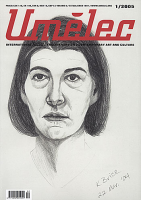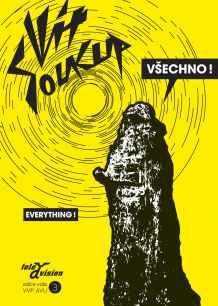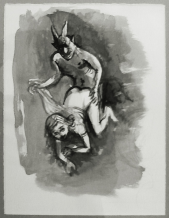| Revista Umělec 2005/1 >> Three Men for Life and Me | Lista de todas las ediciones | ||||||||||||
|
|||||||||||||
Three Men for Life and MeRevista Umělec 2005/101.01.2005 Pavlína Fichta Čierna | commentary | en cs |
|||||||||||||
|
The fourth man that I made sure to stay quiet about was my neighbor Kamil. It took us some time to get used to each other. He was a lonely old man, born in the town of Rosina. I was an outsider, in isolation brought on by motherhood. He would always get me angry as he’d lean out the window on his crutches asking audaciously where I was going and why.
He died this year, on a sunny day in May. He looked awful. That same morning I gave him a kiss on his forehead – probably the only one I ever gave. It could be expected – in his last years he was drinking as much as he could. He didn’t want to live. I was standing in front of the house with Kamil’s nephew, who timidly shook my hand; his was clammy, and radiated a sense of guilt. Soon the undertakers arrived—a luxurious black car, two young people got out. A polished young man and a blond girl in jeans and cap with an American flag on bosom. They studiously shook our hands and examined the situation. With the ease of professionals, they didn’t make any faces when they saw Kamil’s home and him himself. To this day I regret that I was scared and didn’t take any pictures of the moment they carried the poor guy out on a stretcher covered by a blanket. The house remained without Kamil. In my archive there is a slide called Bez Kamila (Without Kamil) that shows us both the way Martin Marenčin photographed us. That was during Kamil’s infirmity, when his legs and hands were swelling, and I had come to assist him. A picture of the burden of loneliness and possible closeness. In the fall of 2003, I was given the opportunity to realize an exhibition in the Gallery of the City of Bratislava, as a winner of the Oskár Čepan prize. I worked on that for long time. I needed a light, white, sterile space. But instead they offered me some dark underground vaulted chambers with only artificial light and stone tiling. The planned project couldn’t be realized and I had to alter the conception completely. I decided to simply destroy the space and use it as a projection room. After some time, my second child was born—Johanka—a year old now, she’s still difficult and still nursing. I was destined to remain a long time in Rosina—a town I don’t come from and, other than my neighbors and a few shop-assistants, I knew nobody. I evaluated my possibilities. I was uninterested in drawing from my own life experiences by tapping into issues associated with family and motherhood. At a time when discussion of feminine and feminist exhibitions in Bratislava was plentiful, I looked elsewhere and focused instead on men without women (or children). And as a continuation of my previous work (with female actors), I concentrated on men who are neither the center of attention nor particularly average; but lacking in something, or perhaps have more of something. They had in common the same regional identity—Žilina and its surroundings—mine; and I knew them all. An alluring candidate for my objective was Jozef. A local artist who is by now (thanks to me, also) known by the entire artistic community in Slovakia, Jozef is a regular visitor to all Žilina openings and has made trips to the Venice Biennale and Documenta in Germany. He is an artist in his soul, with an intelligent expression and exceptional interest. He took my work and his comments very seriously. I made the video-film entitled About Jozef (O Jozefovi) that had elements of documentary. In this, my camera follows him in his distinctive interpretation in the condition of one of the dilapidated buildings of the Slovena factory complex in Žilina, where he works as a steam engineer. He showed me his secret studio filled with a variety artifacts and told me about life and art. I recorded individual pictures with sped up parts and incorporated the music of, Alkatraz, his favorite band, which my daughter also Johanka liked a lot. When she heard it, she ran up to the music with inquisitive delight. I have known the apparently disabled Maroš since childhood. He lives close to my parents, in a quiet Žilina neighborhood. He does his rounds regularly, observing things around him—something that somehow lingers in my thoughts. I often wondered, what was it that he was looking at and what did he notice? It was a sunny spring, I gave the child to my mom. I put the camera in the hands of Maroš and was curious what I would see. I adjusted to his rhythm and routine. I walked in his rounds for a few days, his circuit, and I patiently listened to his endearing comments. He held the camera tightly and wove memories in with the present. The fluctuation of the picture emulated his pace and resonated with an unintended humor and a dash of personal tragedy. The only condition is that the visitor needs to slow down if he wishes to absorb his own self-portrait: the video is pretty long and slow… I worked on it with love. Vlado is a friend of mine. I remembered once when he was slightly tipsy with a wide smile he boasted he was the best and he scrawled it down on a piece of paper to prove it. It looked funny; I keep it at home somewhere. It had no erotic meaning. I never thought about finding out how exactly he meant it, but the moment had a special energy in itself. And he really stands out in the crowd. That was some time ago. He changed a lot when he turned thirty. Since then he has made special statements. That’s what is our video is about. I decided to use a static camera for Vlado. He stares into it and in three intervals of three minutes each he relays the message called From Vlado. He speaks calmly, with the stylized speech of a programmer. He relates his profound belief in God, and talks about his communication with him. The monotone of his confession is reminiscent of a prayer. We discussed every word and every phrase very carefully in advance. I wanted nothing more. The sound, which I processed through three tracks, winds as an endless river appropriate to the individual pictures. Now, as I write this, it’s been a year since the first presentation of the works at the Three men for Life exhibition. Although I paid dearly for all four works, I have come easily to an inner logic with all its meanings intertwined. And communication with the curator of the exhibition, Katarína Rusnáková, enabled me significantly. Each of the works has its own life; and they have in the meantime become a solid part of my life; I have an ongoing relationship with them, just the way I did previously with the mentally disadvantaged Janka Saxonová and her harmonious world. There are unexpected moments in which some of my actors’ words and phrases—that correspond melancholically with reality—leap into my mind. I still focus on subjects that my closest surroundings offer me. Right now I am entangled in the daily life of a local Gypsy family. At two years of age, Johanka is just like she was before. She and her sister Rozálie remain luckily fully part of my daily circulation. I am often tremendously inspired, when I go to the Biennale in Venice and I see all those things there. I can compare them with other things here in Žilina and elsewhere in Slovakia. I have a broader Perspective and I know what I could do next and so on. That is the next launching pad for my work. In the future, I’d really like to continue that way—I’m hoping to eventually find those better spaces. So I don’t have to work as I do in the factory where I run into people who I don’t relate to. They really don’t care what art is. Their values are different and I don’t want to bother them. And when I go to Croatia, I frequently find people who tend to be more sincere than people here. Even though they don’t have much they are still able to be…when a person moves among them they easily sense how to react to them. Such an ability has apparently disappeared in this country. More than once I have found here when a person is really in need hardly anybody helps. And I experienced this again in some cases when I was in Croatia. Whilst Slovaks could care less about me, Croatians and Slovenians would help me out. Such a sad reality that was. And that’s why I feel the way I do. I don’t mean that in any psychological manner— I am trying to find some kind of refuge. …I am busy with that every day; I have no choice, really; I’ve got to do it. I’d like to see the system’s source code. I looked upwards but I couldn’t see through the fog. And then it cleared up. The program is well written, the head analyst wrote it. I don’t have another one so I use it all the time. I am not particularly responsible; the system fails sometimes. A virus got to it again this morning. I’d really like to fall asleep. I’ve got myself to concentrate but it was very hard. …You simply get the ‘cheat,’ even if you don’t look for it. The first one I got was like that. It showed me the way and I went along. According to everything I obviously didn’t become a schizoid. Obviously it is possible to walk freely above the water surface and sometimes even fly. The cheat offers opportunities. Hike up the hill and you can see, can’t you? When I gazed around I changed my mind about the system and about other users, too. It keeps changing, even though the path curves. I’ve since begun to communicate more intensively with the head analyst. Now when I need some cheat, I ask him for it and he decides whether or not to send it to me. Sometimes I request the cheat for somebody else as well. Like Pavlína. That was probably my case. If somebody has communicative interface he should communicate… Notes: 1. Pavlína Fichta Čierna, Three Men for Life, Galéra města Bratislavy, Pálffyho palác, September 10 – October 26, 2003, curator Katarína Rusnáková. 2. From the video S Marošom (With Maroš), Three Men for Life, exhibition at Galéria města Bratislavy, Pálffyho palác. 3. From the video Od Vláda (From Vlado), Three Men for Life, exhibition at Galéria města Bratislavy, Pálffyho palác. Katarína Rusnáková: Zaostrené na mužský subjekt: Videodiela z Pavlíny Fichty Černej (Focused on male subjects: Video-works of Pavlína Fichta Čierna). In: Profil súčasného umenia 1/04, p.70-83.
01.01.2005
Artículos recomendados
|
|||||||||||||
|
04.02.2020 10:17
Letošní 50. ročník Art Basel přilákal celkem 93 000 návštěvníků a sběratelů z 80 zemí světa. 290 prémiových galerií představilo umělecká díla od počátku 20. století až po současnost. Hlavní sektor přehlídky, tradičně v prvním patře výstavního prostoru, představil 232 předních galerií z celého světa nabízející umění nejvyšší kvality. Veletrh ukázal vzestupný trend prodeje prostřednictvím galerií jak soukromým sbírkám, tak i institucím. Kromě hlavního veletrhu stály za návštěvu i ty přidružené: Volta, Liste a Photo Basel, k tomu doprovodné programy a výstavy v místních institucích, které kvalitou daleko přesahují hranice města tj. Kunsthalle Basel, Kunstmuseum, Tinguely muzeum nebo Fondation Beyeler.
|

















































 We Are Rising National Gallery For You! Go to Kyjov by Krásná Lípa no.37.
We Are Rising National Gallery For You! Go to Kyjov by Krásná Lípa no.37.
Comentarios
Actualmente no hay comentariosAgregar nuevo comentario